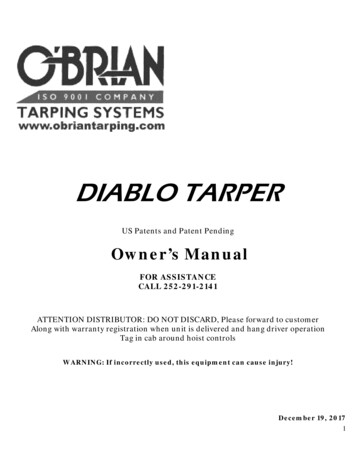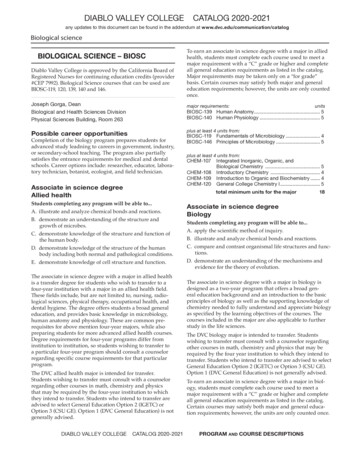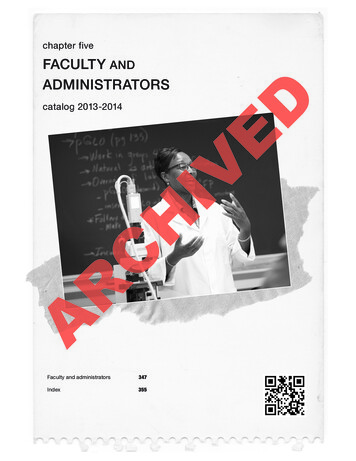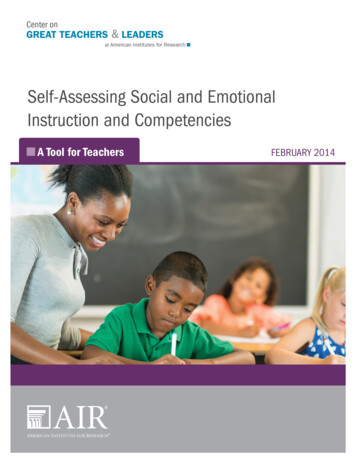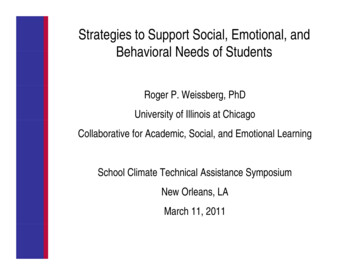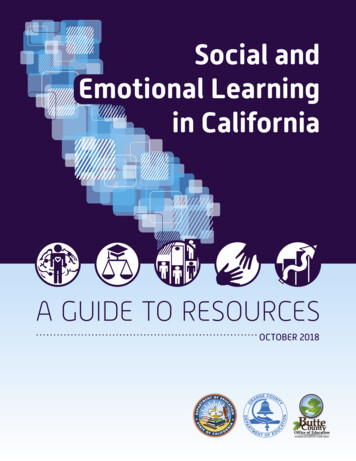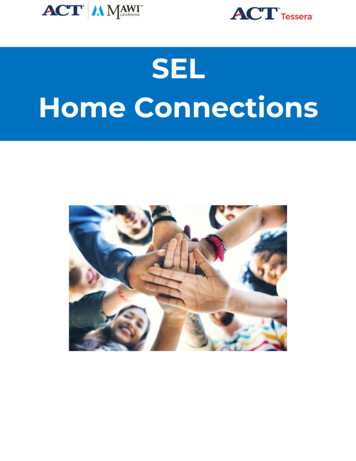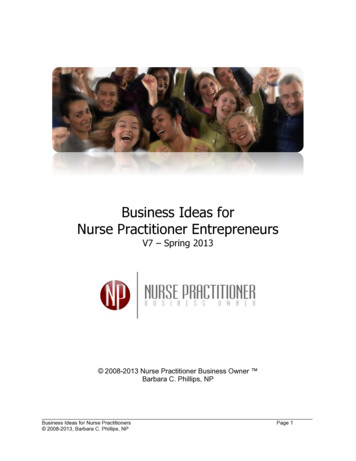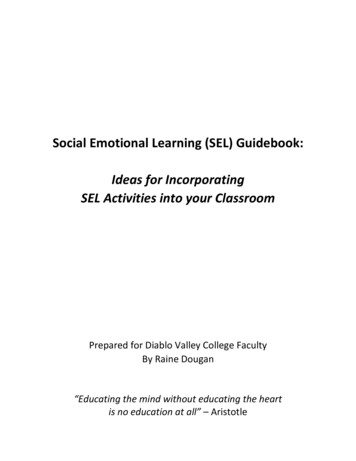
Transcription
Social Emotional Learning (SEL) Guidebook:Ideas for IncorporatingSEL Activities into your ClassroomPrepared for Diablo Valley College FacultyBy Raine Dougan“Educating the mind without educating the heartis no education at all” – Aristotle
IntroductionSocial and Emotional Learning (SEL) is the educational process that helps students develop skills tounderstand and manage their emotions, resolve conflicts, maintain healthy relationships, makeresponsible decisions, and effectively deal with life challenges. SEL develops “emotional intelligence,”which has been demonstrated to have a greater impact on life success than IQ (Goleman).While emotions might seem to be outside the realm of academic learning, a focus on SEL in theclassroom provides many pay offs. Research has repeatedly shown that SEL is critical for success andwell-being in life. People with social and emotional competence are more likely to:- Have a sense of well-being in their personal lives- Act as contributors to their communities- Have meaningful relationships- Feel happiness in their work lives- Feel more optimistic about their future, and- Demonstrate compassion for others (Casel)The positive impact of SEL on academics has also been well documented. Student performanceimproves when social and emotional development is fostered by instructors and institutions. A 2010study by Stanford Professor Gregory Walton and University of Texas at Austin Professor David Yeagerfound that a relatively little amount of social and emotional learning can produce large results.“Recent randomized experiments have found that seemingly “small” social-psychological interventions ineducation — that is, brief exercises that target students’ thoughts, feelings, and beliefs in and aboutschool —can lead to large gains in student achievement and sharply reduce achievement gaps evenmonths and years later. These interventions do not teach students academic content but instead targetstudents’ psychology, such as their beliefs that they have the potential to improve their intelligence orthat they belong and are valued in school” (267).Recent research continues to support the conclusion that SEL curricula improves academic outcomes. ACollaboration for Academic, Social and Emotional Learning (CASEL) study of more than 700 programsfound that if an institution implements a quality SEL curriculum, they can expect better student behaviorand an 11% increase in test scores (Ray).CASEL identifies five key “competencies” that are seen as instrumental in developing positiverelationships and managing life stressors: self-awareness, self-management, social awareness,relationship skills, and responsible decision making. These competencies can broadly be grouped intoskills pertaining to understanding and managing the self and skills related to understanding and relatingto others.This guidebook seeks to share strategies to incorporate SEL into the college classroom, offering generalpractices as well as specific instructional interventions. Strategies are divided into two groups alignedwith SEL competency areas: 1) self-awareness/management skills and 2) social awareness/relationshipskills. The guidebook closes with resources for those who would like to learn more about SEL. I hope youfind the guidebook useful and that you find many ways of incorporating SEL into your classroom.
General approaches and practices to facilitate social and emotional learning in your classroom: Create a warm, safe and supportive learning environment.Develop positive relationships with students. Demonstrate care, concern and a belief in theirability to succeed.Allow opportunities for self-reflection and self-evaluation.Create opportunities for cooperative learning, relationship-building and communication.Attempt to establish an interactive dialogue in class rather than a one-way lecture.Incorporate student interests, experiences, and cultural heritage into the curriculum.Work to foster a growth mindset in students (students with a growth mindset believe thatintelligence can be developed, as opposed to those with a “fixed” mindset who believe thatpeople are born with a certain amount of intelligence and ability).Set high academic standards and communicate them clearly to students.Give students choice when possible to increase motivation and instill a sense of ownership overthe learning process.Adapt teaching methods to address different learning styles.Consider assessment to be feedback for the instructor as well as the student. Implementongoing assessment and adapt instruction as necessary in response to students’ needs.Develop a balance between lecture and active learning, as well as between individual andcollaborative learning.Look for ways to add emotional richness to class content. Students learn and remember bestwhen their emotions are engaged.Continually develop your own emotional intelligence. Practice and model it in your classroom.Specific exercises and interventions to incorporate SEL into the classroom:Self-awareness Write the day’s agenda on the board. Students feel safer when knowing what to expect.At the beginning of the semester, have each student share a “one-minute autobiography”describing themselves and their life experience.Ask students about their previous experience with your subject, and solicit ideas about how theybest learn.Begin class with a couple minutes of mindfulness to calm emotions and focus attention.Engage students in both cognitive and affective inquiry- in addition to asking them what theythink about something they are learning, ask how they feel about it.When studying characters (either fictional or historical), ask students to identify how thecharacters might have felt or be feeling.Conduct quick class “check-ins”, asking students to reflect on their internal state. Check-ins giveinstructors a sense of how students are doing and also send the message to students that theiremotions matter. Examples of check-ins: raise your hand low to high to show your level ofconfidence or confusion with this material; stand and silently dance the way you are feeling atthis moment; name an animal that represents your mood; use a nature metaphor (river,
meadow, etc.) to capture your current mood; report your stress level on a scale of 1 – 10;describe how you are feeling in one word; name a song lyric that expresses your current mood.Pay attention and notice differences in the demeanor and behavior of your students. Inindividual interactions, reflect back to them what you are seeing and inquire about theirattitudes and emotions.Ask students to relate the material discussed in class to their life and personal interests. Havestudents discuss this in small or large groups, or assign writing on the topic. Students will bemore engaged and attentive if they identify personal meaning in the curriculum and studiessuggest their grades will improve significantly. (Godes, et al, 2007).Get to know students’ cultures and interests, using questionnaires or informal discussion, andintegrate the curriculum with material that is relevant to their lives.During test-preparation, schedule time to discuss emotions related to the test. Help normalizestress and fear associated with test-taking.Assign a “core values” exercise in which students write about things that matter most to them.Studies have shown value-affirmation exercises to increase student success and reduce theachievement gap (Cohen, et al, 2009).If you are teaching a class with many new college students, normalize feeling unconnected atfirst but explain that social connections in college develop over time. Consider assigningstudents to write a letter about their transition to college to be shared with new students in afuture semester.Teach new students that poor academic performance is common upon transition to college anddoes not reflect a lack of ability or potential. Reassure students that grades typically improve asthey adjust to the new educational environment. You may share your own academic struggles orthose of past students in your class (without naming names!). Experiments show students giventhis understanding earn higher GPAs and are less likely to drop out of college. (Wilson, et al,2002).Engage students in goal setting. Ask them to imagine their desired future selves, establish goalsto reach this self and identify obstacles that might stand in their way.Help students find their purpose in college by asking them to write about how they wish theworld could be a better place and how doing well in school can help them make a positiveimpact on the world.Explain the difference between intrinsic and extrinsic motivation. Ask student to identify anintrinsic motivator for succeeding in your class.Ask students to think of someone who would be proud of them for succeeding in your class andhave them write that person’s name on their syllabus.Allow time for journaling and reflecting, or encourage/assign it outside of class.Incorporate calming music as a background to learning activities.Self-management Develop class “rules” together- invite students to brainstorm what they need to be successful.Gather ideas into a class contract and have students sign the contract to confirm theircommitment. Refer to the contract throughout semester and allow students to reflect on theirperformance and progress.
Include an academic planner as one of your required course materials. When reviewing thesyllabus, ask students to write due dates and exams in their planners and also encourage themto schedule study time. Refer to the planner throughout the course to encourage students’ useof this self-management tool (e.g. “look at your planner and tell me what is due next Tuesday”).Also consider encouraging students to schedule in weekly stress-management activities.Encourage students to utilize support services throughout the semester including office hours,tutoring and counseling. Explore and debunk common barriers to asking for help including theperception that it makes the student look “stupid” or that the student would be bothering theinstructor.When discussing grades with students, help them distinguish between facts (I got a C on thatpaper) versus self-evaluations (I’m an awful writer) and inferences (my instructor hates me).Provide a few minutes at the end of class for students to get started on their homework. Gettingstarted is often the hardest part about getting it done.Use growth mindset oriented language when giving feedback to students (e.g. “you clearlyworked really hard on that” instead of “you did a great job”).Engage students in researching and teaching others about growth mindset. Ask students toresearch and give a one to two-minute group or individual presentation on growth mindset andwhy it matters.Teach students about learning and the brain. Explain to them that they can become moreintelligent and capable through study and practice. Provide them a hand-out (example below)on how the brain learns and ask them to come up with a plan to maximize their learning in yourclass: http://www.ascd.org/ASCD/pdf/journals/ed lead/el200912 willis.pdfAssign students to read “Myth of I’m Bad at Math” and discuss the myth of limited 0/14/the-myth-of-im-bad-at-math/Discuss with students how mindsets impact learning. Consider showing the 10 minute Ted Talk“The Power of Belief: Mindset and Success” to explain how our understanding of intelligenceand abilities impacts our success: https://www.youtube.com/watch?v pN34FNbOKXcAsk students to make a list of things they consider themselves good at and things that don’tcome easily to them (you could focus on class content, or more broadly on anything in students’lives and experience). Have students identify reasons they might be “good” or “bad” at eachitem on their list, and ask them to share these insights with a partner. Finally, have students picktwo items on the "not good" list and discuss what it would take for them to improve in thatarea.Show students the 9 minute YouTube video “Will Smith: Mindset Wisdom” in which Smithdescribes his fierce work ethic and dedication to improvement through practice:https://www.youtube.com/watch?v XkziAM ZyDM. Ask students to recall a time when theyworked very hard to achieve something, reflecting on what made them work so hard, if theyever felt like giving up, what kept them going, and how they felt when it was done. Dividestudents into small groups to share their reflections.At the beginning of the semester, ask students to anticipate what obstacles to success theymight encounter in your class. Have them create a plan to overcome the obstacles.Ask students to make a short-term improvement plan. Have them identify a goal (could be classcontent or life related) and create a seven-day plan for how and when they’ll work at it. Ask
them to keep a daily journal on how it's going and, when the week has ended, have them reflecton their progress with their classmates.Have students brainstorm and identify their three greatest character strengths. Ask them toimagine and share in pairs how those strengths will help them succeed in your class. Encouragethem to note those strengths on their syllabus or record them in their phone to recall during achallenging time.Invite successful former students back to your class to talk about the challenges they faced andhow they successfully overcame themNear the end of the semester, ask students to write a letter to students who will take the classin the next semester. Ask them to share how they struggled and grew during the class and whatstrategies they used to be successful.Normalize mistakes and teach students that they are valuable learning opportunities. Considershowing students the 15 minute YouTube video “Why You Need to Fail”:https://www.youtube.com/watch?v HhxcFGuKOysAsk students to reflect on a time they made a big mistake. Have them write and/or share whythey made the mistake, how they felt, what they could have done differently and what theylearned from making the mistake.Assign students to interview people in their lives about mistakes they made and what theylearned from them. Have them collect these stories and share them with classmates.Teach students the philosophy of “failing up”, and that mistakes and set-backs can be used aslearning opportunities to propel them forward.To help students focus on the big picture, ask them to suggest exam questions and review thequestions together. You may even select some of the suggestions for the exam and award pointsto those who suggested them.Explore students’ emotions about an upcoming test and help them identify the thoughts thatmight be generating a negative emotion (e.g. “if I fail this test, I’ll never transfer”). Help themreframe their thinking about the test (e.g. “This is one measure of my knowledge. It will notdetermine my entire academic future.”) to see if they can change their negative emotions.Discuss and allow time to practice strategies for reducing test anxiety including visualization,progressive relaxation, and breathing exercises. For more e students write down their fears related to exams or other aspects of the class. Once theirlist is complete, ask them to rip up and recycle their list.When conducting a quiz or exam review, share your “favorite wrong answer” to encourageeffort and de-stigmatize mistakes. Without naming the student, share what you appreciate inthe answer and have students identify what was done right before pointing out the error.Ask students to conduct self-assessments on their class performance, identifying strategies andbehaviors that are working well for them and anything that needs to be changed or improved.Self-assessment could be built in to the testing process, with a reflective assignment followingreturn of exams and quizzes.Conduct some “emotional coaching” after an exam. Remind students that the pursuit ofknowledge is hard work and can be painful at times. Encourage them to make learning their goalrather than earning a specific grade. Reassure them that your critical feedback is a sign of yourhigh academic standards and your belief in their potential to reach those standards.
Set up opportunities for “productive struggle”, allowing students time to work on a problemindependently or in small groups before bringing the topic to a lecture or larger discussion.Demonstrate your own continual learning and development. Ask students for feedback on theeffectiveness of your teaching practices and look for ways to incorporate feedback and makeimprovements.For subjects in which students look for solutions to problems, ask students to come up withmultiple ways to find the solution. Facilitate discussion on the different approaches and askstudents to identify and explain what worked best.Social Awareness/Relationship Skills Demonstrate warmth and support for students by following up with their concerns, askingquestions about their experience, and helping them feel included in class.Recognize students’ worth and value and reflect it back to them with feedback and appreciation.Try to arrive a few minutes early to welcome students as they arrive, and stay a few minutesafter class to follow up with students of concern.Be willing to engage with students if you see them outside of class.Get to know students’ academic goals, ask them to reflect on how the class is connected tothose goals.Incorporate team-building activities at the beginning of the semester. Human Bingo is a great“get to know you” activity to use early in the semester. Create a card with information related toyour students (e.g. “born in another country” or “plays an instrument”) and have them findpeople who match each category. Students try to complete the card, filling in the names ofstudents who fit in each category.Have students do paired introductions at the beginning of the semester. Ask them to connectwith someone they don’t know and give them 3-5 questions to ask (name, major, life goal, heroor role model, etc.) Students interview each other and then introduce their partner to the restof the class.Facilitate group discussions- ask open-ended questions, allow discussion to be student-driven,help students understand how to listen and how to elaborate. Consider configuring students’desk in a circle for these discussions.Ask frequent questions to continually engage students in what they are learning. Have studentsteach back a concept covered or specific steps to a problem. Rather than waiting for students toraise their hands, try to include the entire class and call on students randomly.If conducting a lecture, break the lecture into smaller chunks and incorporate activities anddiscussions in between lecture presentation.Assign and facilitate collaborative learning projects in which students rely on each other tosucceed. During the project, have students monitor their own progress and develop their ownrubric for evaluation. Allow time for students to reflect on how they worked together and givefeedback on what you observed.Acknowledge racism, sexism and other bias as it exists in your subject area and allow students toshare their reactions.Evaluate your relationships with individual students in your class. Choose a couple students eachweek and try to strengthen your relationship by connecting with them individually for feedback,follow up and support.
When referring students to campus services, provide a personal reference and consider walkingthem to the service to help them make the connection.Consider mandating campus relationship-building behavior by including attending office hours,utilizing tutoring services and visiting the library or Counseling Center in class requirements.Create opportunities for peer tutoring in class.Incorporate service learning activities to create meaning in the curriculum.Additional SEL resources for educators:Web-based resources Article on helping students cultivate how to help students develop hopeArticle on “Using Emotional Intelligence to icleDisplay.cfm?ID 285Emotional intelligence assessment for teachers: l-learning-quizArticle on productive struggle: roductive-struggle-ellie-cowenWonderful website with mindset information and activities: https://www.mindsetkit.org/Free, online growth mindset interventions for college students, developed by StanfordUniversity: https://www.perts.net/orientation/cg17More resources in developing resilience, grit, and growth esourcesGrowth mindset lesson plan: er s on adjusting teaching style to students’ learning t/index.htmMath exercises with more than one right answer. “Open tasks” help develop growth mindsetsby focusing on the learning process rather than the answer: https://www.youcubed.org/tasks/Poster on positive norms to encourage in math: /Norms-Poster-2015.pdfMathematical Mindsets card: -logo.pdfSuggestions for teaching math as a social activity (geared toward elementary education butsome ideas could be transferable to the college setting): rative-learning-videoSix tips for brain-based learning: s-brainbased-learning-guide-print.pdf
Bill & Melinda Gates Foundation report on “Academic Tenacity: Mindsets and Skills thatPromote Long-Term Learning”: /dweckwalton-cohen-2014.pdfWebsite with lots of great research and examples of SEL interventions, particularly onestargeting underserved groups: m-LearningTeam-building activities for the classroom: /Guidelines for developing “juicy” questions: ide.pdfArticle on the connection between feeling powerful and l-makes-you-think-better/.Article on tips to get students tivated?referrer exchangesArticle on how to motivate students to work der/379500/Teaching tips from Eric Jensen, author of Teaching with Poverty in erty-in-mind#postcommentArticle on how mindset and a sense of belonging (along with other factors) affects ability tograduate: ts-to-graduate.htmlA research review and overview of SEL: omesGreater Good Science Center article making the case on teaching happiness em/should student success include happinessBooks and Journal Articles Willis, Judy. Learning to Love Math: Teaching Strategies that Change Student Attitudes and GetResults. ASCD, 2010.Vail, Pricilla. Emotion: The On Off Switch for learning. Modern Learning Press, 1981.Mendoza-Denton, Rodolfo, et al. “Sensitivity to Status based rejection: Implications for African–American Students’ College Experience.” Journal of Personality and Social Psychology, 2002, Vol83, pp. 896 – 918.Miyake, Akira, et al. “Reducing the Gender Achievement Gap in College Science: A ClassroomStudy of Values Affirmation.” Science, 2010, pp. 1234 - 1237.Gay, Geneva. Culturally Responsive Teaching: Theory, Research and Practice. 2nd ed., CollegePress, 2010.Hammond, Zaretta. Culturally Responsive Teaching and the Brain: Promoting AuthenticEngagement and Rigor Among Culturally and Linguistically Diverse Students. Corwin, 2015.
LeDoux, Joseph. “Emotion, Memory and the Brain.” Scientific American, 1994, Vol 270, pp. 50 57Jensen, Eric. Teaching with Poverty in Mind: What Being Poor Does to Kids’ Brains and WhatSchools Can Do About It. ASCD, 2009.Elias, Maurice. “Strategies to Infuse Social and Emotional Learning into Academics.” BuildingAcademic Success on Social Emotional Learning: What Does the Research Say? Edited by JosephZins, et al., Teachers College Press, 2004, pp. 113 - 134.Manring, Susan L. “Tapping and Fostering Students' Emotional Intelligence Through ServiceLearning Experiences.” Journal of Behavioral and Applied Management, 2012, Vol 13, No. 3, pp.168 - 185.Kingston, Emma. “Emotional Competence and Drop-Out Rates in Higher Education.” Education& Training, 2008, Vol 50, No 2, pp. 128 - 139.Works CitedGoleman, Daniel. Emotional Intelligence: Why it Can Matter More Than IQ. Bloomsbury, 2010.“SEL Impact.” CASEL: Educating Hearts, Inspiring Minds. http://www.casel.org/impact/Walton, Gregory and David Yeager. “Social-Psychological Interventions in Education: They’re NotMagic.” Review of Educational Research, June 2011, Vol. 81, pp. 267 - 301.Ray, Betty. “Q&A with Daniel Goleman: How the Research Supports Social-Emotional Learning.”Edutopia, 7 October, 2014, rch-supports-selbetty-ray.Godes, Olga, et al. “Enhancing Interest and Performance with a Utility Value Intervention.” Journal ofEducational Psychology, 2010, Vol 102, No 4, pp. 880 – 895.Cohen, Geoffrey, et al. “Recursive Processes in Self-Affirmation: Intervening to Close the MinorityAchievement Gap. Science Magazine, April 2009, pp. 400 – 403.Wilson, Timothy, et al. “Improving the Academic Performance of College Students with BriefAttributional Interventions.” Improving Academic Achievement. Edited by Joshua Aronson, AcademicPress, 2002, pp. 89 – 108.
responsible decisions, and effectively deal with life challenges. SEL develops “emotional intelligence,” which has been demonstrated to have a greater impact on life success than IQ (Goleman). While emotions might seem to be outside the realm of academic learning



